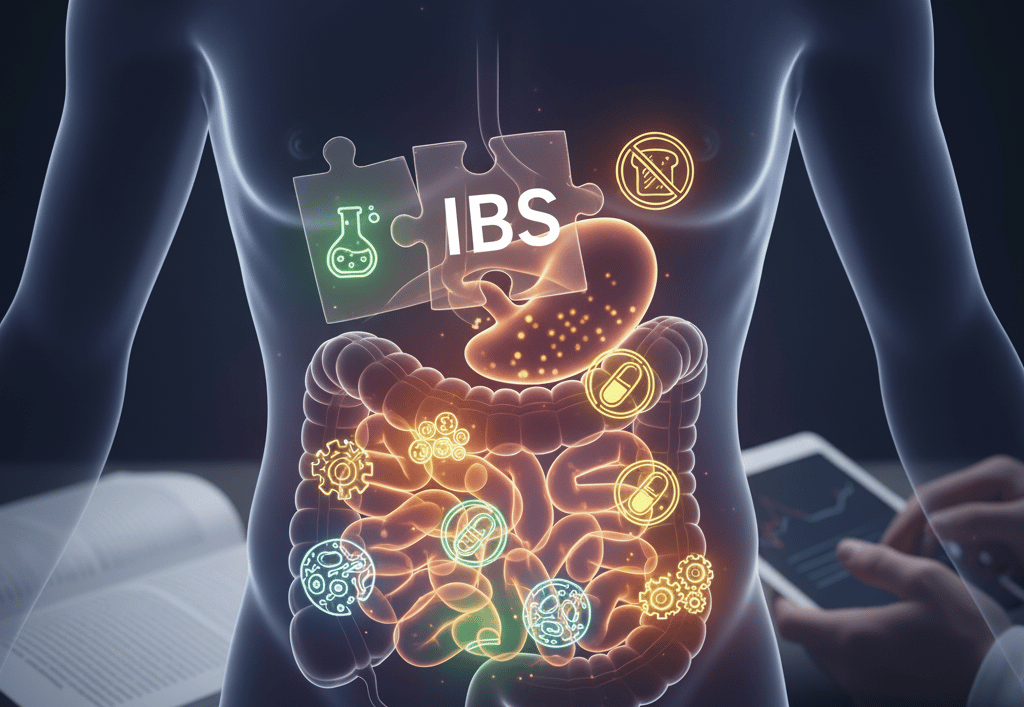5 Conditions That Masquerade as IBS
The Truth About Your IBS: Study Suggests Nearly 50% of Cases Are Misdiagnosed Treatable Conditions.
Nuri El azem De haro
10/10/20255 min read


Is Your Irritable Bowel Diagnosis Not Improving? You Might Have Something Else
If you live with a diagnosis of Irritable Bowel Syndrome (IBS), you're likely all too familiar with the frustration. Abdominal pain, bloating, and unpredictable changes in your bowel habits can quickly take control of your life. IBS is often considered a "functional disorder," meaning it's diagnosed based on symptoms when no clear organic or structural cause is found.
But what if that "organic cause" simply hasn't been looked for hard enough?
A revealing 2022 study published in the prestigious journal Scientific Reports has brought this problem into focus. It is a systematic review and meta-analysis—one of the highest levels of scientific evidence—that analyzed decades of research (from 1978 to 2020). The conclusion is clear: a highly significant proportion of patients diagnosed with IBS in specialized care actually suffer from one of several organic and, more importantly, treatable diseases.
The study exhaustively analyzed the prevalence of five organic disorders in patients who had already been diagnosed with IBS. Here, we break down each one, explaining what it is, how it's diagnosed, and how common it turned out to be in the study.
The 5 Diseases That Masquerade as IBS
The researchers focused on five specific conditions that are often overlooked and whose symptoms overlap almost perfectly with those of IBS. The results are surprising, showing the frequency with which they appear in people who already had an IBS diagnosis.
1. Bile Acid Diarrhea (BAD) 🧪
What is it? The liver produces bile acids to help digest fats. Normally, these are reabsorbed in the final part of the small intestine. In BAD, this reabsorption process fails, and an excess of bile acids reaches the colon. The colon reacts to this excess by secreting water, causing chronic, watery diarrhea.
Diagnosis: The study mentions several tests, the most common being the SeHCAT scan, which measures how much bile salt the body retains over 7 days. It can also be diagnosed by measuring bile acids in stool or through a blood test (the 7$\alpha$-C4 marker).
Prevalence Found: The results were surprisingly high. Using the most common diagnostic criterion (SeHCAT retention <15%), the pooled prevalence was 41%. This means that 2 out of 5 patients with a prior diagnosis of IBS with diarrhea could actually have this underlying condition. The prevalence for severe BAD (retention <5%) was 12%.
2. Carbohydrate Malabsorption (CM) 🍞
What is it? This is the small intestine's inability to adequately absorb certain sugars, such as lactose (from milk sugar) or fructose (from fruit sugar). When these sugars are not absorbed, they travel to the colon, where bacteria ferment them. This fermentation process produces gas, bloating, pain, and diarrhea.
Diagnosis: Generally done using a hydrogen breath test. The patient consumes a dose of the sugar in question, and hydrogen levels in their breath are measured at regular intervals. A significant increase indicates that bacteria are fermenting the unabsorbed sugar.
Prevalence Found: It is extremely common among IBS patients.
Lactose Malabsorption: Found in 54% of patients analyzed across 26 different studies.
Fructose Malabsorption: Detected in 43% of patients in 13 studies.
The study also notes malabsorption of other sugars like sorbitol, with a gross rate of 47.3% in the few studies that analyzed it.
3. Small Intestinal Bacterial Overgrowth (SIBO) 🦠
What is it? The small intestine normally has a relatively low bacterial population compared to the colon. SIBO is a condition where there is an excessive number of bacteria in the small intestine. These bacteria can interfere with nutrient digestion and absorption, in addition to fermenting food prematurely, causing severe bloating, gas, pain, and diarrhea or constipation.
Diagnosis: Can be diagnosed with breath tests (using lactulose or glucose as a substrate) or, more invasively but accurately, by analyzing a culture of fluid aspirated directly from the small intestine.
Prevalence Found: Results vary enormously depending on the test used, reflecting the existing controversy over the best method.
Using the lactulose breath test: A prevalence of 49%.
Using the glucose breath test: A prevalence of 19%.
Using the intestinal aspirate: A prevalence of 13%. The authors highlight that the lack of standardization in breath testing is a major problem contributing to this high variability.
4. Microscopic Colitis (MC) 🔬
What is it? This is inflammation of the colon that is invisible to the naked eye during a colonoscopy. It can only be diagnosed by taking biopsies of the colon tissue and examining them under a microscope. There are two main subtypes: lymphocytic colitis and collagenous colitis. Its main symptom is persistent, watery diarrhea.
Diagnosis: A colonoscopy with biopsies is essential. A normal result from a colonoscopy without biopsies does not rule out this disease.
Prevalence Found: The study estimated an overall rate of 3% across 17 different studies. Although the percentage seems low, it is an important cause of chronic diarrhea that is often overlooked. Lymphocytic colitis (5%) was more common than collagenous colitis (0-1%).
5. Exocrine Pancreatic Insufficiency (EPI) 💊
What is it? This is a condition in which the pancreas does not produce enough digestive enzymes to break down food (especially fats). This leads to poor digestion, which can cause diarrhea (often with greasy stools), weight loss, and nutritional deficiencies.
Diagnosis: Commonly diagnosed with a non-invasive test that measures the level of the enzyme elastase-1 in a stool sample. A low level indicates EPI.
Prevalence Found: Based on only two studies, a gross rate of 4.6% was found. The authors caution that this result should be interpreted carefully, as severe diarrhea can dilute the stool sample and lead to a false positive, overestimating the prevalence.
Study Strengths: Why We Should Pay Attention
This is not just another study. Its strength lies in its rigorous design as a systematic review and meta-analysis. Instead of conducting a new experiment, the researchers compiled and statistically analyzed data from dozens of prior, high-quality studies.
Furthermore, they only included studies where patients met strict diagnostic criteria for IBS (such as the Rome criteria) and where the other diseases were diagnosed with recognized medical tests. This ensures that "apples are not being compared to oranges" and lends much more solidity to the results.
Limitations: A Dose of Scientific Realism
Like any good research, the authors themselves point out some important limitations that we should keep in mind:
Study Heterogeneity: The analyzed studies, although high quality, presented differences in their methods, diagnostic criteria, and the patients included. This can introduce variability into the final results.
Imperfect Diagnostic Tests: Some of the tests used to diagnose these conditions—especially the breath tests for SIBO and carbohydrate malabsorption—are not 100% accurate, and their interpretation can vary.
Research Context: Almost all studies were conducted in a secondary or tertiary healthcare setting (i.e., with gastroenterology specialists). This means that the prevalence figures might not be the same for patients who are only treated by their primary care physician.
What Does All This Mean For You?
The main conclusion is clear and hopeful: if you have been diagnosed with IBS and conventional treatments are not working for you, it might be time to take another step.
This study strongly suggests that an IBS diagnosis should not be the end of the road, but perhaps the beginning of a deeper investigation. Diseases like Bile Acid Diarrhea, SIBO, or Microscopic Colitis have specific treatments that are very different from those for IBS and that can lead to real improvement in symptoms.
Talk to your doctor. Mention this type of research and ask if it would be appropriate in your case to run tests to rule out these other conditions. A correct diagnosis is the first step toward reclaiming your quality of life.
